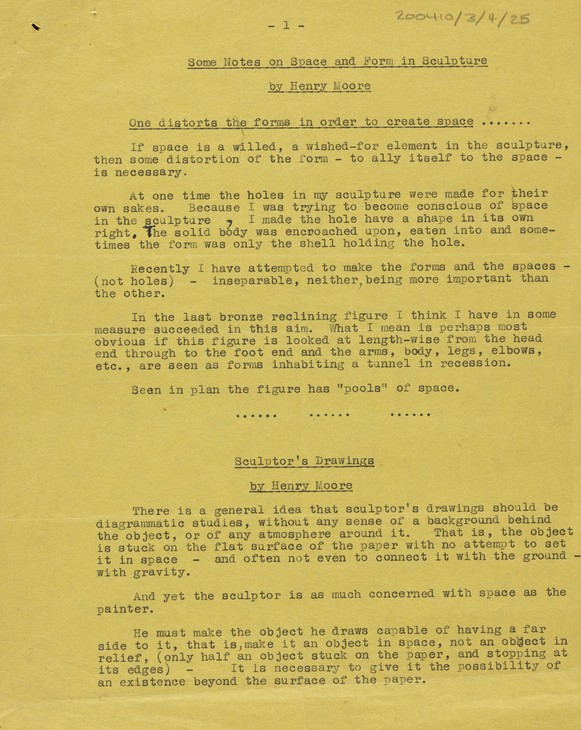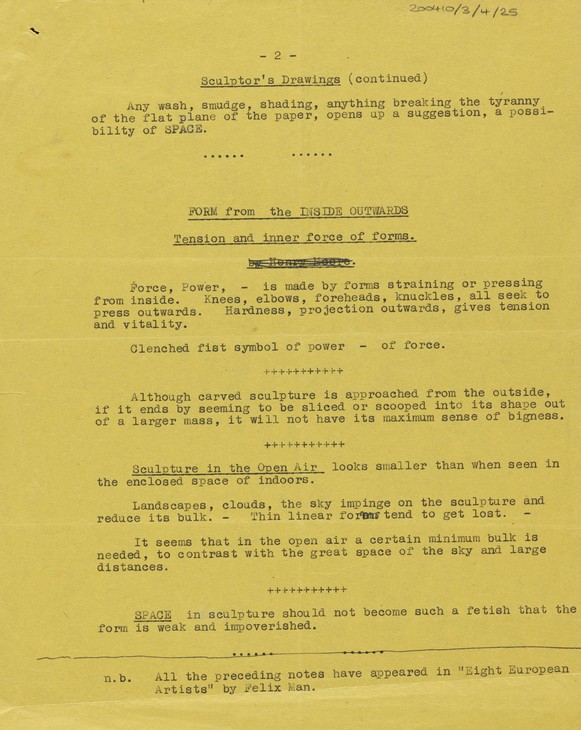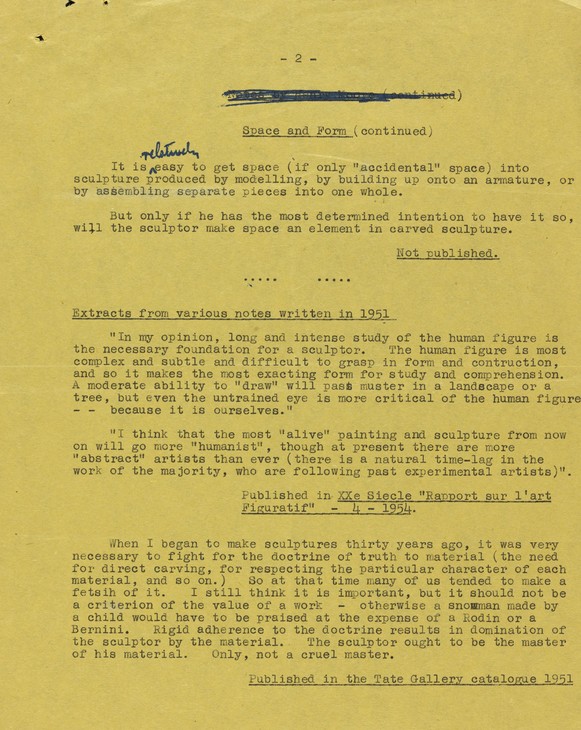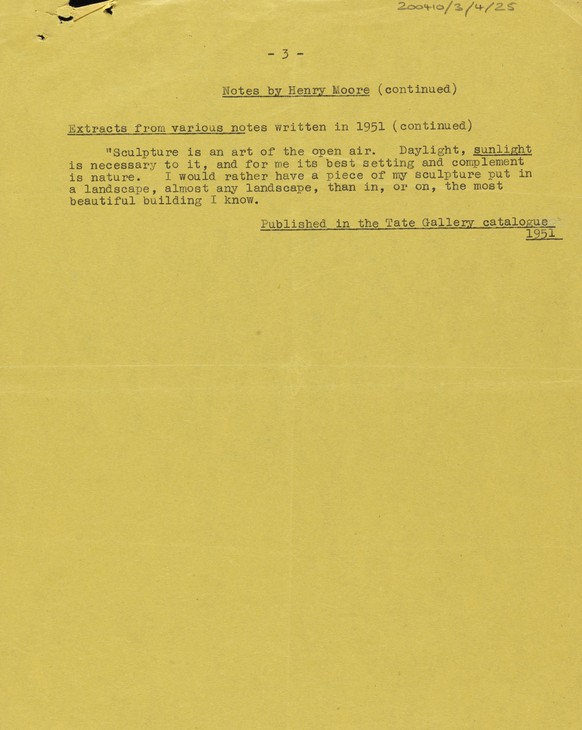Henry Moore Some Notes of Space and Form in Sculpture 1970
During the late 1930s Henry Moore contributed to Axis (1935–7), a journal edited by Myfanwy Piper that sought to place British art within an international context. In 1937 Piper edited a book of artists’ statements, The Painter’s Object, to which Moore contributed ‘The Sculptor Speaks’, an article that had been published in the Listener earlier that year.
In 1970 Piper asked Moore to send some recent statements about his work in preparation for a new edition of The Painter’s Object. This five-page document offered a selection of both published and unpublished statements by Moore.
Transcript
[Typescript with some handwritten corrections:]
Some Notes on Space and Form in Sculpture
by Henry Moore
by Henry Moore
One distorts the forms in order to create space ...
If space is a willed, a wished-for element in the sculpture, then some distortion of the form – to ally itself to the space – is necessary.
At one time the holes in my sculpture were made for their own sakes. Because I was trying to become conscious of space in the sculpture, I made the hole have a shape in its own right. The solid body was encroached upon, eaten into and sometimes the form was only the shell holding the hole.
Recently I have attempted to make the forms and the spaces – (not holes) – inseparable, neither being more important than the other.
In the last bronze reclining figure I think I have in some measure succeeded in this aim. What I mean is perhaps most obvious if this figure is looked at length-wise from the head end through to the foot and the arms, body, legs, elbows, etc., are seen as forms inhabiting a tunnel in recession.
Seen in plan the figure has ‘pools’ of space.
Sculptor’s Drawings
by Henry Moore
by Henry Moore
There is a general idea that sculptor’s drawings should be diagrammatic studies, without any sense of a background behind the object, or of any atmosphere around it. That is, the object is stuck on the flat surface of the paper with no attempt to set it in space – and often even to connect it with the ground – with gravity.
And yet the sculptor is as much concerned with space as the painter.
He must make the object he draws capable of having a far side to it, that is, make it an object in space, not an object in relief, (only half an object stuck on the paper, and stopping at its edges) – It is necessary to give it the possibility of an existence beyond the surface of the paper. [end of p.1]
Sculptor’s Drawings (continued)
Any wash, smudge, shading, anything breaking the tyranny of the flat plane of the paper, opens up a suggestion, a possibility of SPACE.
FORM from the INSIDE OUTWARDS
Tension and inner force of forms.
Tension and inner force of forms.
Force, Power, – is made by forms straining or pressing from outside. Knees, elbows, foreheads, knuckles, all seek to press outwards. Hardness, projection outwards, gives tension and vitality.
Clenched fist symbol of power – of force.
Although carved sculpture is approached from the outside, if it ends by seeming to be sliced or scooped into its shape out of a larger mass, it will not have its maximum sense of bigness.
Sculpture in the Open Air looks smaller than when seen in the enclosed space of indoors.
Landscapes, clouds, the sky impinge on the sculpture and reduce its bulk. – Thin linear forms tend to get lost. –
It seems that in open air a certain minimum bulk is needed, to contrast with the great space of the sky and large distances.
SPACE in sculpture should not become such a fetish that the form is weak and impoverished.
n.b. All the preceding notes have appeared in “Eight European Artists” by Felix Man. [end of p.2]
Notes by Henry Moore (1951)
Space and Form
Some definitions of sculpture
“Sculpture is an infinite number of contours”. This definition suggests looking only at the flat silhouette, whereas sculpture should be looked at also from the middle outwards.
“Sculpture is the science of the hollow and the bump” (Rodin). This is a more three dimensional attitude – but still for me does not include the special sense that sculpture should have. “The hollow and the bump” describes surfaces only.
“Sculptural energy is the mountain” (Gaudier Breszka). This is still talking of surfaces, of relief, of projection rather than volume – for the mountain is a pimple on the earth’s surface – it is the earth itself which gives the full idea of form.
Complete three dimensional form – form in the round – is form in space, the far side of a form should be known when seeing the front of it, its volume should be comprehended, which is the space that the form displaces in the air.
When fully comprehended, form and space are one and the same.
Published in XXe Siecle (2 – 1952)
Difference between modelling and carving in the approach to SPACE
Modelling Begins with an armature, a thin form in space and gradually clothes this with clay, wax, plaster, or whatever modelling material is used. – That is, you are given space and make forms in it.
Carving Starts with a sold block which has surfaces but no space. The line of least resistance in directly carved sculpture is to make only relief form from different sides, to cut surface forms which have no complete existence, but are left embedded in the solid matrix. To make complete three-dimensional form in carving, it is necessary, besides thinking of the outer surfaces of forms, to think of the centres of forms, so that they exist from INSIDE OUTWARDS.
Not Published. [end of p.3]
Space and Form (continued)
It is relatively easy to get space (if only “accidental” space) into sculpture produced by modelling, by building up onto an armature, or by assembling separate pieces into one whole.
But only if he has the most determined intention to have it so, will the sculptor make space an element in carved sculpture
Not published
Extracts from various notes written in 1951
“In my opinion, long and intense study of the human figure is the necessary foundation for a sculptor. The human figure is most complex and subtle and difficult to grasp in form and construction, and so it makes the most exacting form for study and comprehension. A moderate ability to ‘draw’ will pass muster in a landscape or a tree, but even the untrained eye is more critical of the human figure – because it is ourselves.”
“I think that the most ‘alive’ painting and sculpture from now on will go more ‘humanist’, though at present there are more ‘abstract’ artists than ever (there is a natural time-lag in the work of the majority, who are following past experimental artists)”.
Published in XXe Siecle “Rapport sur l’art Figuratif” – 4 – 1954.
When I began to make sculpture thirty years ago, it was very necessary to fight for the doctrine of truth to material (the need for direct carving, for respecting the particular character of each material, and so on.) So at that time many of us tended to make a fetish of it. I still think it is important, but it should not be a criterion of the value of a work – otherwise a snowman made by a child would have to be praised at the expense of a Rodin or a Bernini. Rigid adherence to the doctrine results in domination of the sculptor by the material. The sculptor ought to be the master of his material. Only, not a cruel master.
Published in the Tate Gallery catalogue 1951[end of p.4]
Notes by Henry Moore (continued)
Extracts from various notes written in 1951 (continued)
“Sculpture is an art of the open air. Daylight, sunlight is necessary to it, and for me its best setting and complement is nature. I would rather have a piece of my sculpture put in a landscape, almost any landscape, than in, or on, the most beautiful building I know.
Published in the Tate Gallery catalogue 1951.
How to cite
Henry Moore, Some Notes of Space and Form in Sculpture, 1970, in Henry Moore: Sculptural Process and Public Identity, Tate Research Publication, 2015, https://www





